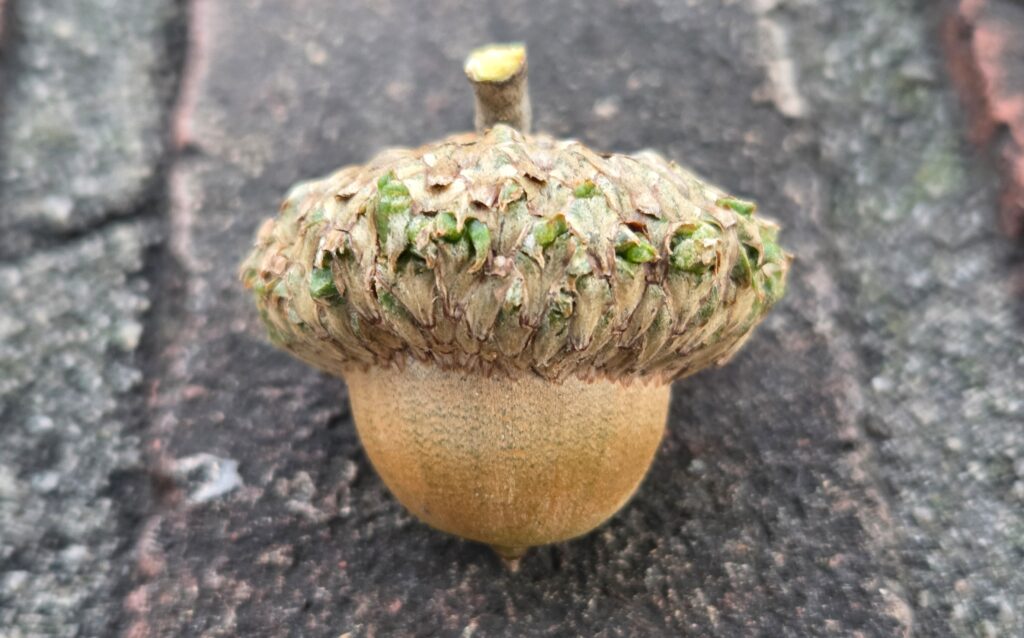
Mmmm. Nutty.
This is the fourth in a series on Downtown Chapel Hill trees. Parts one and two covered East Franklin Street from Columbia Street to the Post Office. Part three covered the southside of West Franklin.
Hello all. We’re back on West Franklin Street. Perhaps we’ve amped up the neuronal firing rate with an afternoon coffee from Epilogue (my choice when the need arises to relocate physically and mentally from the workaday wring-around) and there is time to saunter a few hundred paces or more gently downslope towards the bathtub bottom of downtown. Well, let’s do that.
A visit with West Franklin Street’s trees
On the North side of the street this time, we’ll pick up on the recently repopulated northwest corner of Columbia and Franklin, former home to Copytron, the finest copy store in the land, in the time when photocopiers were a necessary tool in the continuation of our shared language, the propagation of our evolving art. (Mapquest still shows it at 100 W. Franklin St. on a quick online search, how about that?) Now this corner has wrapped its glass and brick and plastic around a franchised shop called Pulp Juice and Smoothie Bar. It is gratifying to see something aside from vacancy there. And this is where we will take notice of our first (of many) trees (and a few commercial establishments) on this short stroll.
Trees 1 & 3: Scarlet oak
The leaves of Scarlet Oak (Quercus coccinea) are a bit like pin oak, slightly shocked, textured in a way that is a product of the spaces unoccupied, inasmuch as the spaces actually containing leafy green. The sinuses are C-shaped and the lobes are noticeably bristly. It’s an attractive arrangement, in my opinion. The fall color on this species is also worth noting. A good choice for a street tree as it will not aspire to supersize as it matures. Nice to start the tour with a plant that’s not from the usual. Too many willow oaks, too much time and energy spent later on removing plants that were always going to get too big for their intended homes. This species is also the third in line heading down the street, at the bus stop that sits where Caribou Coffee used to be—or the Pump House, Margot asks me to remind the townies among you. It’s a lovely space; we must ask ourselves why no business has enjoyed a longer run there. Alas, outside of the scope of this article, feel free to discuss amongst yourselves.

Scarlet Oak (Quercus coccinea)
Tree 2: American elm
In between these two youngish oaks, we find an elm, likely a cultivated form more suited for a life in concrete. The species one finds in more hospitable spots is Ulmus americana. There are more than a few cultivars and hybrids that will tolerate the less-than-ideal conditions and, more importantly, are less prone to Dutch Elm Disease, a fatal (introduced) pathogen that has wiped streets clean of this excellent tree in many neighborhoods over the years. ‘Jefferson’, ‘Valley Forge’, ‘Princeton’ and ‘Frontier’ (a hybrid cultivar) are all grown and sold as hardier alternatives to the species. The leaves have a light serration and a light green that shows well against the darker exterior of the adjacent buildings. This tree’s new neighbor is White Sauce Grill, a relative newcomer to the block. I wish them both well!

Some flavor of elm (Ulmus americana)…
Trees 4 & 21: Pin oak
Next up is a fine-looking oak tree in front of the former location of Walker’s Funeral Home. Perhaps they still own the building, using it for storage, perhaps? Long-term storage? Regardless, the fine folks of Walker’s pulled up stakes and slid south a few miles and are now in a shiny new space just up from Cole Park. Chatham County, y’all. They left behind this lovely specimen tree, really nice form for a Pin Oak (Quercus palustris). The lowest limbs, which usually slope downward towards the ground, have all been removed, leaving a pleasing, rounded half dome of a tree, fully clothed and quite healthy in appearance. Well done, tree. There’s another pin oak down the way in front of the University Development Office (UDO).
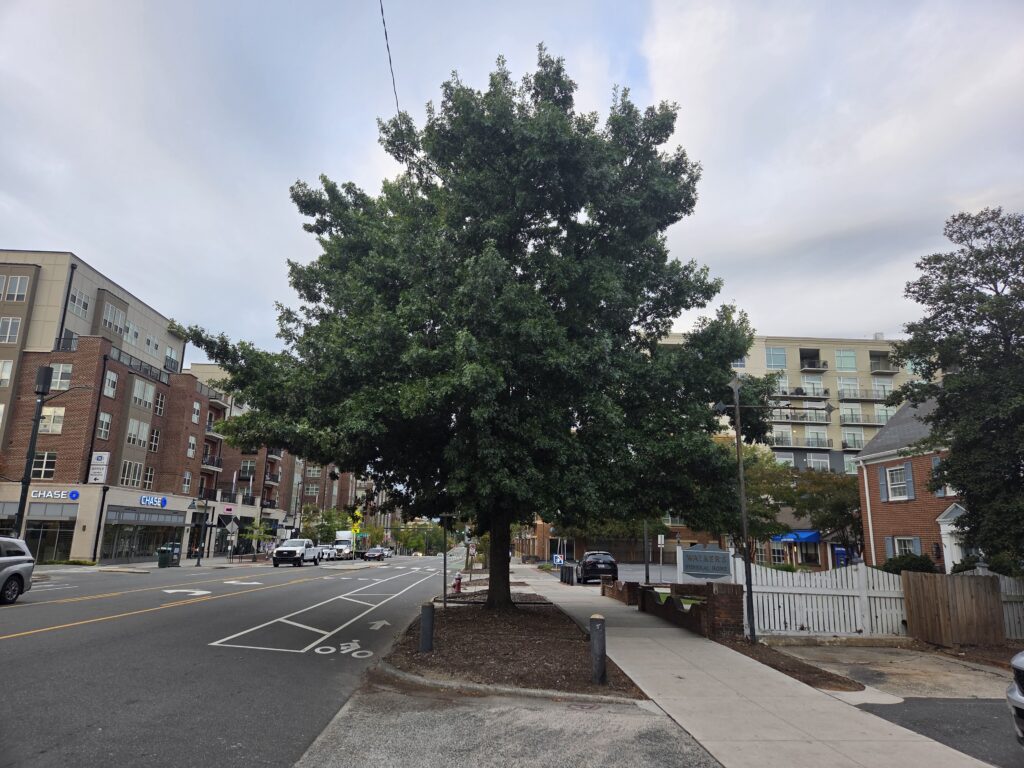
Walker’s Pin Oak (Quercus palustris)
Trees 5 & 6: American elm & generic maple
On the other end of the health spectrum is a rather sad and not-long-for-this-streetscape elm. Again, likely a cultivated form. Not really worth spending too much keyboard time on this one; she’s destined for the mulch pile. Or should be…(I have noted that one of the side effects of a career in horticulture is a predilection for judginess, haven’t I? Well, if not, there it is. It’s a perk.)
Right across the driveway from that is a generic maple. The cultivars available for challenging locations are generous. The folks in the nursery trade do delight in engaging in plant husbandry. As a species, we’ve been at it for millennia—better wheat, better corn, better rice, prettier flowers, shapelier shrubs, hardier trees, all part of the business of plant breeding. I certainly do not wish to imply that these trees are less important than their neighbors. More that I’m spending less effort on the details of certain individuals as I’m certain they will not be in these spaces a short time from now. At least I hope not. A dead or dying tree stood up along a downtown byway is kinda worse than no tree at all. Ooh, judgy.
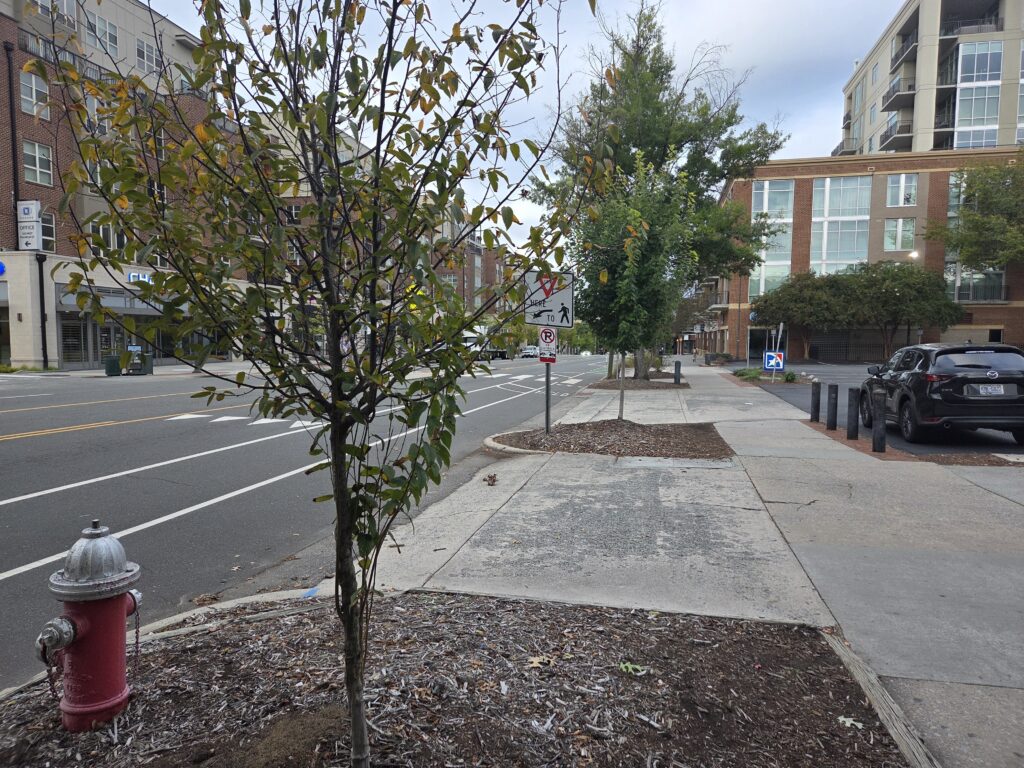
Temporary inhabitants
Trees 7 & 8: Willow oak & crepe myrtle
Moving along…we now find ourselves in front of First Horizon Bank. Former location of a full-service gas station and garage (I believe we just called them ‘service stations’ growing up). Margot informs me it was Obie Davis Exxon, née Esso. Neat that the building was kept intact. It’s slightly out of step with the giant pile just a few yards west, but I appreciate the visual reminder that our little downtown was once closer to us in scale. Don’t get me wrong, I’m a huge fan of interesting infill and diversity through density, just noting the step in scale. The trees here are a willow oak (Quercus phellos) and a crepe myrtle (Lagerstroemia indica).
The oak is a bit ragged at the tips. A visual hiccup that can be smoothed over with a bit of thoughtful pruning and monitoring over the next few years. Nice to see a crepe myrtle in the mix! This tree is not native to the Southeastern U.S., but it’s been here so long we tend to think of it in the same way we do the neighbor’s kid who manages to show up at just the right time on pizza night. Even when you switch up which night you decide to order. What’s one more for supper, right? Pull up a chair.
Assuming the oak makes it through its terrible twos, its diminutive neighbor will likely be shadowed into a thinner and thinner existence, then nothing. Perhaps the space can be given over to a lovely patch of cut-leaf coneflowers or turtleheads, or maybe a couple of smooth hydrangeas. A fella can dream. Two more crepe myrtles (Trees 17 &18) are sitting happily (or so I imagine) in front of Might As Well, where they actually have room to be, hopefully not requiring much in the way of sharp-edged attention as they mature. Same for the specimens in front of Fifth-Third Bank (Trees 24 & 26) at the bottom of the block.
Allons-y!
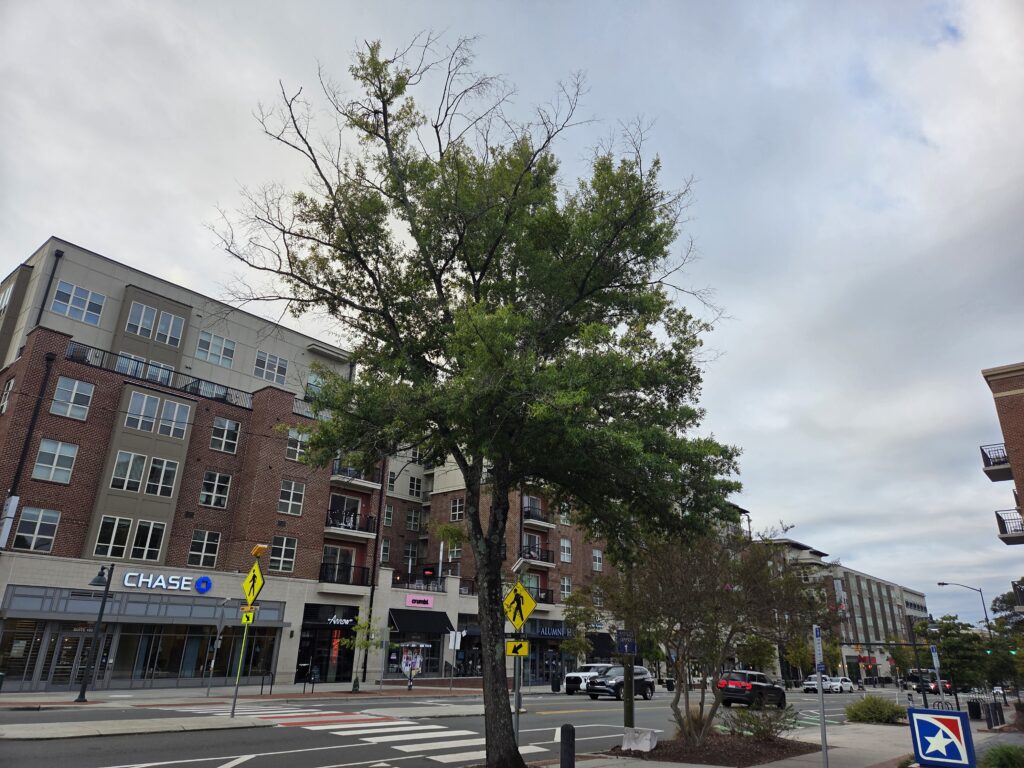
Willow oak (Quercus phellos) and crepe myrtle (Lagerstroemia indica)
Trees 9-16: Willow oaks
There was a sale somewhere, must’ve been. One cannot fail to note that many of this species have been removed from the surrounding neighborhood (W. Franklin St. closer to Carrboro and along Cameron Ave in particular) over the past seven years or so. The big ones removed included a beauty down in front of Chapel Hill Tire that surely was six feet thick at head height. It’s what they do. The specimen in McCorkle Place, across the street from the Post Office, was planted a mere 110 years ago…take a look next time you stroll that way.
My point with this observation is to note that adding this tree into the streetscape at the 140 West Franklin Street Plaza knowingly introduces a maintenance regime that town employees will inherit from the folks who did the planting. Right plant, right place. And I’m not convinced that willow oak is the right tree in this place. It’s fast and can get quite wide about the waist as it ages. That’s all. I’ll tuck my judgy face back into its little box, now.

Willow Oaks at 140 West Franklin Street Plaza
Soapbox Moment #1
We made it to the stoplight! Crossing over Church St into the realm of the 200 block of W. Franklin, there are four more willow oaks. Instead of further lamentation about this choice of planting, let’s pause for a moment and reflect on this corner, which started out its three-dimensional existence as the original location of the Baptist Church that would later move up to the corner of Franklin and Columbia (and remain as University Baptist). The building then stood as a Lodge for the Free Masons (who have yet to ask me to join…) and then as a Belk’s department store. Those of you reading who were around at that time and later, like Margot, recall the Belk’s with some fondness, I suspect. She vividly remembers shopping there as a kid—freely roaming three stories of clothing and home goods, including a huge department of fabric and “notions”, a term that still makes her giggle. (I arrived to the village post-Belk’s, yet have no difficulty opining about the utter lack of useful businesses along Franklin St. [you know, like somewhere that isn’t being boycotted {looking at you, Target} to buy a sink strainer or any of the little necessities we now clamber into our vehicle to haul ourselves out to the outskirts to forage and find – but I digress]. Really, I was just looking for a legit way to insert two parenthetical expressions inside another parenthetical expression.) Of course, Belk’s later sloughed off its retail skin to reveal a shiny and shimmying Cat’s Cradle. Margot reports a long-standing rumor of a makeshift bowling alley occupying the cavernous second floor during that particular incarnation. Back to the trees.

More willow oaks at W. Franklin & Church Streets
Tree 19: Japanese maple
I’m going to skip over the next little tree. It’s a weeping Japanese maple (Acer palmatum cv.) that might have been an attractive plant at one point. Now it is beaten up and half gone. Removal would be the aesthetically and, Margot interjects, the morally correct thing to do. I’ll spare our gentle readers the photo. Please avert your eyes as you pass out of respect.
Tree 20: Weeping yaupon holly
Between the bar and the UDO is a pocket garden with a cute squiggly walkway and a pretty weeping yaupon holly (Ilex vomitoria ‘Pendula’) that fills the slice of non-buildings in between perfectly. I bring this up even though it’s not really on the street just because I can. If you’re walking downhill on that side of the street, pause and look to your right. It’s great.
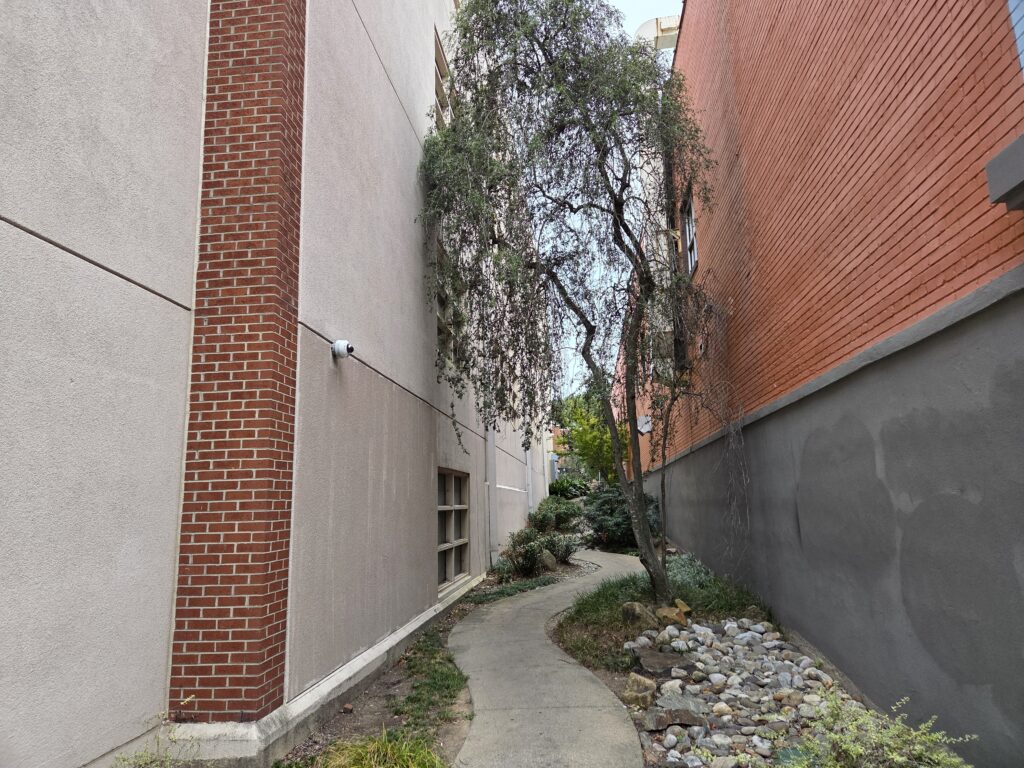
Yaupon holly (Ilex vomitoria) on a squiggly walkway
Soapbox Moment #2
Margot here with some insights on our little holly friend. Yaupon is America’s only native source of caffeine. For coffee achievers like Geoffrey and me, that’s what you call a truly fun fact. I’ve had it before and it’s tasty stuff. If coffee prices continue to rise, I might make it my daily. For centuries, Indigenous people have roasted the leaves for tea for daily drinking, medicinal use and rituals. The origins of its scientific name (my Mom’s favorite!), however, are steeped in lore of uncertain veracity. Some will tell you ilex vomitoria is so called because explorers and colonists spread a story about the tea being part of an Indigenous purification ceremony that resulted in a lot of vomiting. The tale made it to the plant’s namer, Scottish botanist William Aiton. Others attribute more nefarious tactics to the handle, saying European tea traders lobbied Aiton to use the icky name because they didn’t want competition from the New World (a theory since debunked). Never mind that the subsequent vomiting was later discovered to be from consuming vast quantities of a concentrated beverage made from the leaves and other ingredients, not the yaupon itself.
Trees 22 & 23: Oaks
In front of Bicycle Chain is a nondescript oak that I’m struggling a bit with. I’m inclined to say pin oak again, allowing for the high variability in oak morphology (fancy way of saying no two are exactly alike) and its popularity along the street. It was also early one morning when I was having my first proper look at these trees, and I’m sure I was not paying sufficient attention. I’ll get back there at some point soon and make sure I’m delivering accurate info to all concerned. The other tree is a willow oak. No mistaking that one.
Margot wants me to point out that she’s made it this far without mentioning the regional habit of calling willow oaks pin oaks. Huzzah?

Another pin oak
Trees 25: Southern red oak
As we approach the intersection with Mallette St., let’s appreciate the last two crepe myrtles in our cohort in front of Fifth Third Bank, bookending a small, slightly struggling Southern red oak (Quercus falcata). This tree will be a nice addition to this end of the street, should it survive, easily capable of overtopping the (currently) adjacent buildings and helping ease the overheating a bit with generous shade. Margot reminds me to tell you about a terrific book, Doug Tallamy’s The Nature of Oaks, a deliciously deep dive into these native trees.
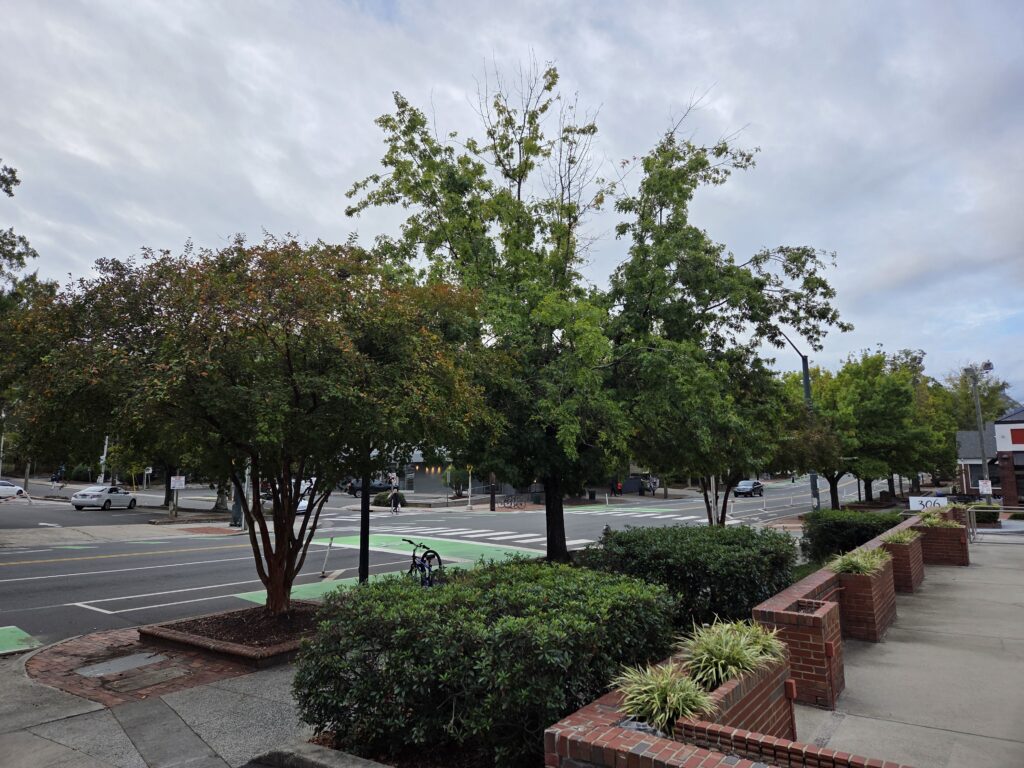
The last three trees
Two blocks and 26 trees on the north side of the street. That’s a gracious plenty! I’ve spoken often on the essential roles plants play in our lives. We all know it in the deeper places within us.* The connections are ofttimes unnoticed, ignored, but they remain.
Thanks again for taking the time to browse these articles. I hope you’ll take a minute or 20 and move about the spaces without walls. Meet the neighbors. We’ll talk more next month.
* Pssst. It’s Margot sneaking in here one last time: There are a lot of scientific and cultural reasons we connect deeply with trees. One of my favorites is fractals, recurring patterns in the natural world, many of which mimic patterns in our own bodies. Biologist Merlin Sheldrake explains that if we stop to notice fractals, “we’d see the veins and capillaries running through our lungs would be outlines of oaks and the cross-sections of sheepshead mushrooms. We were part of this, we’d have known. All we had to do was be quiet.” Right?! Two books, if you’re interested in learning more about how nature affects us: Sheldrake’s Entangled Life: How Fungi Make Our Worlds, and Your Brain on Nature by Eva Selhub & Alan C. Logan.
(All photos by Geoffrey Neal)
Geoffrey Neal is the director of the Cullowhee Native Plant Conference. See more of his photography at soapyair.com, @soapyair and @gffry. Margot Lester is a certified interpretive naturalist and professional writer and editor. Read more of her work at The Word Factory.

About the name: A refugium (ri-fyü-jē-em) is a safe space, a place to shelter, and – more formally – an area in which a population of organisms can survive through a period of unfavorable conditions or crisis. We intend this column to inspire you to seek inspiration and refuge in nature, particularly at the Arboretum!

